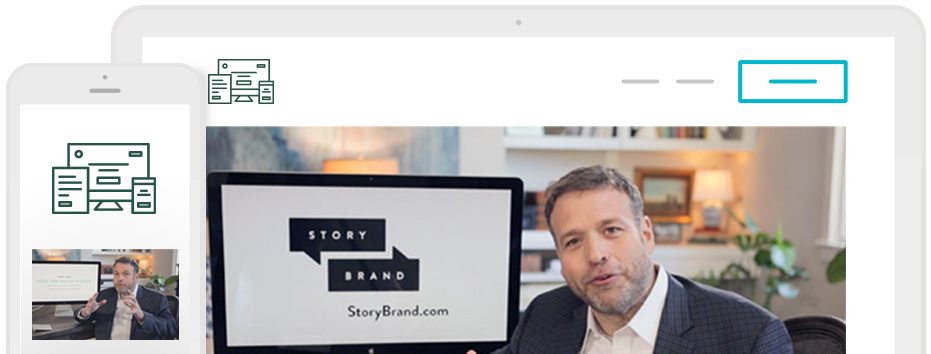
You keep reading articles and hearing podcasts about the importance of content marketing for your business.
You’ve heard how it can generate leads that turn into sales. You know it helps your Google search rankings. You know it’s a major part of establishing trust and authority (which, in StoryBrand lingo, is key to being a great guide to your customers).
So, given all the benefits of content marketing, why do so many of us have a hard time consistently creating great content — whether it’s blog posts, lead generators, newsletters, or PDFs?
I’ve found that for a lot of companies (especially small businesses and solopreneurs), the process of creating content can be overwhelming.
But it gets a lot easier when you can break it down into simple steps. Follow this process and it will help you create the kind of content that can transform your marketing.
Brainstorm ideas for compelling content
Great content starts with a great topic. And the work you do in this step is critical to your content’s success. According to this study, the #1 thing that makes content effective is relevance to the audience.
The best topics allow you to showcase your expertise AND address a question or problem your customer commonly faces. Here are great sources of inspiration:
• Survey data: Review survey data from your audience and look for common themes. (This very blog post comes from our own survey data, where we directly asked what kind of content our customers want to read.)
• Social media: Scroll through your most popular Facebook posts and tweets and consider ways you can expand and develop them.
• Old content: If you’ve been in business awhile, you can dust off old content and update it with new information and insight.
Just remember — if you’re using this content to build trust with leads, your topic needs to appeal to the same kind of person who would eventually buy your product.
Establish Your Big Idea and Outline It
Now that you’ve got your topic, it’s time to unpack it. The best way to do this is to create a simple outline. Just roughly lay out the major points you want to make. If you collaborate with a team, this is a good time to share the outline and get input and buy-in from everybody else before you begin writing.
As a part of this process, create a short one-liner that describes the value your content will provide to your reader.
Create a short one-liner that describes the value your content will provide to your reader.
For example, the big idea for this blog post is just:
This post will break down content creation into a simple process so readers can create content more quickly and easily.
This statement is your “north star” to help you keep your writing clear and focused. Make sure everything you write lines up with this big idea.
This is also the time to start brainstorming titles for your piece. I could write a whole post on this, but in general, anchor the title around the same big value you established in your one-liner.
One other note: you may find, in this stage, that your topic is too broad, too narrow, or unclear. That’s okay. Adjust it or scrap it. Trust me, it’s better to figure that out now, in the planning stages, than to write the whole piece only to find you’ve got a sprawling, unfocused mess.
Gather Supporting Research
Now that you’ve got a working topic and outline, it’s time to research. You’re looking for material that adds dimension to each big idea in your outline. In my research, I consider:
– Quotes
– Statistics
– Pop culture references
– Scientific studies
– Examples
– Articles
– Tweets
– Anecdotes and stories
The scope of your research depends on the kind of content you’re creating and who you’re writing for. Some blog posts may only need a bit of support, while a whitepaper may require extensive research.
Also, bear in mind that your research may shift your outline. Tweak it if you need to as you dig into your topic, and keep referencing that “north star” statement to make sure you’re staying focused on the same big idea.
Write a Bad First Draft
So now I’ve got some good news. At this point, you haven’t written a word of your content yet, but you’re already 80% done. That’s because you’ve done the hard work of simplifying and clarifying your points. And that’s mostly what writing is.
Now just get your first draft down on paper. Don’t worry too much about the actual words either. Just keep your butt in the chair, as Anne Lamott is fond of saying.
How to write: Butt in chair. Start each day anywhere. Let yourself do it badly. Just take one passage at a time. Get butt back in chair.
— ANNE LAMOTT (@ANNELAMOTT) July 26, 2012
Also, turn off any devices and apps that ding at you, and choose a time of day when you’re at your best. For me, it’s first thing in the morning, with coffee and my dog Lucy, out in the writing shed behind our house.
Edit, Polish, and Proofread
The best thing you can do for your first draft is nothing. At first, anyway.
In other words, wait a day (or at least several hours), and then go back and read your draft.
Start by reviewing that “north star” one-liner you created, and keep it in mind as you review. Then, get ruthless. Make cuts or rewrite whole sections as you find material that doesn’t support that big idea. You want to make sure you’re delivering on the promise of the content’s value.
The best thing you can do for your first draft is nothing. At first, anyway.
You may need to take a few passes before you have a draft you’re satisfied with. For more help with editing your copy, check out this post, How to Take Your Sales Copy From Meh to Amazing.
At this point, you’re ready to polish the language and proofread for typos and grammar. Or pass it off to your favorite English language enthusiast to do it for you.
Add Design and Visuals
Our amazing brains can process visuals 60,000 times faster than it can process text, according to research by the 3M Corporation.
That’s why it’s critical to create space in your process for finding great visuals for your content. They draw in your readers and bring your content to life.
Depending on the kind of content you’re creating, you might want to consider the visuals much earlier in the process, during the outline.
Common visual elements in content include:
• Custom illustrations
• Compelling photography
• Designed images featuring shareable quotes from your content
• Infographics to underscore points about data
• Screenshots of examples that illustrate your points
Conduct a Final Review and Publish
Okay, you’re in the homestretch now. Your final step is to look at the content and images together in the same context your readers will experience them in.
For example, if you’re writing a blog post, make sure you review it in “preview” mode in its final form. You’ll make edits to copy when you see it in context that wouldn’t have occurred to you when you read it in a Word document.
Then, publish it or send it to press and go get some ice cream to celebrate.
—
Now that you’re done, it’s time to promote your content (on social media or in an email campaign, for example). Also, don’t forget to build analysis into your process, so you always remember to see how your content performed.
What’s great about following this process is that it also allows you to predict how long it’ll take you to create a piece of content and plan your schedule accordingly. This helps you get more consistent with your content, which is critical to your long-term success.
I hope this process makes creating great content easier for you. Give it a try and be sure and share your tips with me in the comments.

Improve Your Marketing This Week
In three short videos, my 5 Minute Marketing Makeover will show you the common problems most small businesses make on their websites — and how to fix them. Discover tweaks you can make this week to boost your sales right away.










